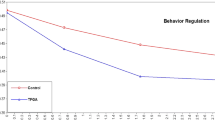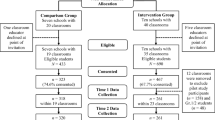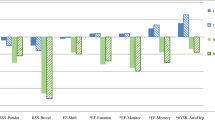Abstract
Efficient and effective social-emotional learning programs increase the likelihood of success in school for all students, and particularly for those who may develop emotional or behavior problems. In this study, we followed a sub-sample of students 1 year after their participation in a randomized controlled trial of the effects of the Tools for Getting Along (TFGA) curriculum. TFGA is a universally delivered, preventive cognitive-behavioral curricular intervention designed to improve upper elementary school students’ emotional and behavioral self-regulation. To determine effects at 1-year follow-up, we assessed 720 out of the 1,296 original students across TFGA and control conditions on measures of curricular knowledge, teacher-rated executive function and behavior, and student-reported anger and social problem solving. Findings indicated a continued positive effect on curricular knowledge for students taught TFGA relative to controls. We also found significant pretest by condition interaction effects on teacher reports of skills associated with executive function, including inhibitory control and shift (cognitive flexibility), and on teacher reported internalizing and externalizing behavior. Specifically, students with poorer scores on these measures at pretest benefited from TFGA at follow-up relative to comparable students in the control condition. Finally, we found marginally significant pretest by condition interaction effects on proactive aggression, outward expressions of anger, and the executive function related skills of initiating activities and using working memory. Counter to expectations, we found negative TFGA effects on student-reported trait anger and anger control.

Similar content being viewed by others
References
Akers, R. L., & Sellers, C. S. (2009). Criminological theories: Introduction, evaluation, and application (5th ed.). New York: Oxford University Press.
Alberto, P. A., & Troutman, A. C. (2012). Applied behavior analysis for teachers (9th ed.). Upper Saddle River, NJ: Merrill/Prentice Hall.
August, G. J., Realmuto, G. M., Hektner, J. M., & Bloomquist, M. L. (2001). An integrated components preventive intervention for aggressive elementary school children: The Early Risers program. Journal of Consulting and Clinical Psychology, 69, 614–626.
Baddeley, A. (2007). Working memory, thought, and action. Oxford: Oxford University Press.
Bandura, A. (1986). Social foundations of thought and action: A social cognitive theory. Englewood Cliffs, NJ: Prentice-Hall.
Benjamini, Y., & Hochberg, Y. (1995). Controlling the false discovery rate: A practical and powerful approach to multiple testing. Journal of the Royal Statistical Society: Series B (Methodological), 57(1), 289–300.
Bierman, K. L. (2004). Peer rejection: Developmental processes and intervention strategies. New York: Guilford.
Bracken, B. A., & Keith, L. K. (2004). Clinical assessment of behavior. Lutz, FL: Psychological Assessment Resources.
Conduct Problems Prevention Research Group. (2002). The implementation of the Fast Track program: An example of large-scale prevention science efficacy trial. Journal of Abnormal Child Psychology, 30, 1–18.
Conduct Problems Prevention Research Group. (2010). The effects of a multi-year randomized clinical trial of a universal social-emotional learning program: The role of student and school characteristics. Journal of Consulting and Clinical Psychology, 78, 156–168.
Cooke, M. B., Ford, J., Levine, J., Bourke, C., Newell, L., & Lapidus, G. (2007). The effects of city-wide implementation of second step on elementary school students prosocial and aggressive behaviors. Journal of Primary Prevention, 28(2), 93–115.
Crick, N. R., & Dodge, K. A. (1994). A review and reformulation of social information-processing mechanisms in children’s social adjustment. Psychological Bulletin, 115, 74–101.
D’Zurilla, T. J., Nezu, A. M., & Maydeu-Olivares, A. (2002). Social Problem-Solving Inventory-Revised (SPSI-R): Technical manual. North Tonawanda, NY: Multi-Health Systems.
D’Zurilla, T. J., Nezu, A. M., & Maydeu-Olivares, A. (2004). Social problem solving: Theory and assessment. In E. C. Chang, T. J. D’Zurilla, & L. J. Sanna (Eds.), Social problem solving: Theory, research, and training (pp. 11–27). Washington, DC: American Psychological Association.
Daunic, A. P., Smith, S. W., Brank, E. M., & Penfield, R. D. (2006). Classroom based cognitive–behavioral intervention to prevent aggression: Efficacy and social validity. Journal of School Psychology, 44, 123–139.
Daunic, A. P., Smith, S. W., Garvan, C. W., Barber, B. R., Becker, M. K., Peters, C. D., et al. (2012). Reducing developmental risk for emotional/behavioral problems: A randomized controlled trial examining the Tools for Getting Along curriculum. Journal of School Psychology, 50, 149–166.
Dishion, T. J., Poulin, F., & Burraston, B. (2001). Peer group dynamics associated with iatrogenic effects in group interventions with high-risk young adolescents. In D. W. Nangle & C. A. Erdley (Eds.), The role of friendship in psychological adjustment (pp. 79–92). San Francisco: Jossey-Bass.
Dodge, K. A. (1986). A social information processing model of social competence in children. In M. Perlmutter (Ed.), Minnesota symposium on child psychology (Vol. 18, pp. 77–125). Hillsdale, NJ: Erlbaum.
Dodge, K. A., & Coie, J. D. (1987). Social-information-processing factors in reactive and proactive aggression in children’s peer groups. Journal of Personality and Social Psychology, 53, 1146–1158.
Dodge, K. A., Lansford, J. E., Burks, V. S., Bates, J. E., Pettit, G. S., Fontaine, R., et al. (2003). Peer rejection and social information processing factors in the development of aggressive behavior problems in children. Child Development, 74, 374–393.
Duchnowski, A. J., Kutash, K., & Friedman, R. M. (2002). Community-based interventions in a system of care and outcomes framework. In B. J. Burns & K. Hoagwood (Eds.), Community treatment for youth: Evidence-based interventions for severe emotional and behavioral disorders (pp. 16–37). New York: Oxford University Press.
Durlak, J. A., Weissberg, R. P., Dymnicki, A. B., Taylor, R. D., & Schellinger, K. B. (2011). The impact of enhancing students’ social and emotional learning: A meta-analysis of school-based universal interventions. Child Development, 82, 405–432.
Eisenberg, N., Valiente, C., Spinrad, T. L., Cumberland, A., Liew, J., Reiser, M., et al. (2009). Longitudinal relations of children’s effortful control, impulsivity, and negative emotionality to their externalizing, internalizing, and co-occurring behavior problems. Developmental Psychology, 45, 988–1008.
Fraser, M. W., Day, S. H., Galinsky, M. J., Hodges, V. G., & Smokowski, P. R. (2004). Conduct problems and peer rejection in childhood: A randomized trial of the Making Choices and Strong Families programs. Research on Social Work Practice, 14, 313–324.
Fraser, M. W., Galinsky, M. J., Smokowski, P. R., Day, S. H., Terzian, M. A., Rose, R. A., et al. (2005). Social information-processing skills training to promote social competence and prevent aggressive behavior in the third grade. Journal of Consulting and Clinical Psychology, 73, 1045–1055.
Fraser, M. W., Lee, J. S., Kupper, L. L., & Day, S. H. (2011). A controlled trial of the Making Choices program: 6-month follow-up. Research on Social Work Practice, 21, 165–176.
Fraser, M. W., Nash, J. K., Galinsky, M. J., & Darwin, K. E. (2000). Making choices: Social problem-solving skills for children. Washington, DC: NASW Press.
Frey, K. S., Hirschstein, M. K., & Guzzo, B. A. (2000). Preventing aggression by promoting social competence. Journal of Emotional and Behavioral Disorders, 8, 102–112.
Gerber, M. M., & Solari, E. J. (2005). Teaching effort and the future of cognitive-behavioral interventions. Behavioral Disorders, 30, 289–299.
Gioia, G. A., Isquith, P. K., Guy, S. C., & Kenworthy, L. (2000). Behavior rating inventory of executive function professional manual. Lutz, FL: Psychological Assessment Resources Inc.
Gioia, G. A., Isquith, P. K., Kenworthy, L., & Barton, R. M. (2002a). Profiles of everyday executive function in acquired and developmental disorders. Child Neuropsychology, 8, 121–137.
Gioia, G. A., Isquith, P. K., Retzlaff, P. D., & Espy, K. A. (2002b). Confirmatory factor analysis of the Behavior Rating Inventory of Executive Function (BRIEF) in a clinical sample. Child Neuropsychology, 8, 249–257.
Greenberg, M. T. (2004). Current and future challenges in school-based prevention: The researcher perspective. Prevention Science, 5(1), 5–13.
Grossman, D. C., Neckerman, H. J., Koepsell, T. D., Liu, P. Y., Asher, K. N., Beland, K., et al. (1997). Effectiveness of a violence prevention curriculum among children in elementary school: A randomized controlled trial. Journal of the American Medical Association, 277, 1605–1611.
Hofmann, W., Schmeichel, B. J., & Baddeley, A. D. (2012). Executive functions and self-regulation. Trends in Cognitive Sciences, 16(3), 174–180.
Hudley, C., Britsch, B., Wakefield, W. D., Smith, T., Demorat, M., & Cho, S. (1998). An attribution retraining program to reduce aggression in elementary school students. Psychology in Schools, 35, 271–282.
Hughes, C. (2002). Executive functions and development: Why the interest? Infant and Child Development, 11, 69–71.
Kam, C., Greenberg, M. T., & Kusché, C. A. (2004). Sustained effects of the PATHS curriculum on the social and psychological adjustment of children in special education. Journal of Emotional and Behavioral Disorders, 12, 66–78.
Kazdin, A. E. (1997). Practitioner review: Psychosocial treatments for conduct disorder in children. Journal of Child Psychology and Psychiatry, 38, 161–178.
Kazdin, A. E., Siegel, T., & Bass, D. (1992). Cognitive problem-solving skills training and parent management training in the treatment of antisocial behavior in children. Journal of Consulting and Clinical Psychology, 60, 733–747.
Kerr, M. A., & Schneider, B. H. (2008). Anger expression in children and adolescents: A review of the empirical literature. Clinical Psychology Review, 28, 559–577.
Kochanska, G., Murray, K. T., & Harlan, E. T. (2000). Effortful control in early childhood: Continuity and change, antecedents and implications for social development. Developmental Psychology, 36, 220–232.
Laird, R. D., Jordan, K. Y., Dodge, K. A., Pettit, G. S., & Bates, J. E. (2001). Peer rejection in childhood, involvement with antisocial peers in early adolescence, and the development of externalizing behavior problems. Development and Psychopathology, 13(2), 337–354.
Landry, S. H., Smith, K. E., & Swank, P. R. (2009). New directions in evaluating social problem solving in childhood: Early precursors and links to adolescent social competence. In C. Lewis & J. I. M. Carpendale (Eds.), Social interaction and the development of executive function. New directions in child and adolescent development, 123, 51–68.
Larkin, R., & Thyer, B. A. (1999). Evaluating cognitive-behavioral group counseling to improve elementary school students’ self-esteem, self-control, and classroom behavior. Behavioral Interventions, 14, 147–161.
Lewis, C., & Carpendale, J. I. M. (2009). Introduction: Links between social interaction and executive function. In C. Lewis & J. I. M. Carpendale (Eds.), Social interaction and the development of executive function. New directions in child and adolescent development, 123, 1–15.
Lochman, J. E., & Wells, K. C. (2002). The Coping Power Program at the middle school transition: Universal and indicated prevention effects. Psychology of Addictive Behaviors, 16(Suppl.), S40–S54.
Lochman, J. E., & Wells, K. C. (2004). The Coping Power program for preadolescent aggressive boys and their parents: Outcome effects at the one-year follow-up. Journal of Consulting and Clinical Psychology, 72, 571–578.
Lyons, K. E., & Zelazo, P. D. (2011). Monitoring, metacognition, and executive function: Elucidating the role of self-reflection in the development of self-regulation. Advances in Child Development and Behavior, 40, 379–412.
McMahon, S. D., & Washburn, J. J. (2003). Violence prevention: An evaluation of program effects with urban African-American students. Journal of Primary Prevention, 24, 43–62.
Miller-Johnson, S., Coie, J. D., Maumary-Gremaud, A., Bierman, K., & Conduct Problems Prevention Research Group. (2002). Peer rejection and aggression and early starter models of conduct disorder. Journal of Abnormal Child Psychology, 30, 217–230.
Muthén, L. K., & Muthén, B. O. (1998–2012). Mplus user’s guide (7th ed.). Los Angeles, CA: Author.
Neilans, T. H., & Israel, A. C. (1981). Towards maintenance and generalization of behavior change: Teaching children self-regulation and self-instructional skills. Cognitive Therapy and Research, 5(2), 189–195.
Oldehinkel, A. J., Hartman, C. A., Winter, A. F. D., Veenstra, R., & Ormel, J. (2004). Temperament profiles associated with internalizing and externalizing problems in preadolescence. Development and Psychopathology, 16, 421–440.
Olson, S. L., Sameroff, A. J., Kerr, D. C. R., Lopez, N. L., & Wellman, H. M. (2005). Developmental foundations of externalizing problems in young children: The role of effortful control. Development and Psychopathology, 17, 25–45.
Phipps, S., & Steele, R. (2002). Repressive adaptive style in children with chronic illness. Psychosomatic Medicine, 64, 34–42.
Polsgrove, L., & Smith, S. W. (2004). Informed practice in teaching self-control to children with emotional and behavioral disorders. In R. B. Rutherford, M. M. Quinn, & S. R. Mathur (Eds.), Handbook of research in emotional and behavioral disorders (pp. 399–425). New York: Guilford Press.
R Core Team. (2012). R: A language and environment for statistical computing. R Foundation for Statistical Computing, Vienna, Austria. ISBN 3-900051-07-0. http://www.R-project.org/.
Riggs, N. R., Greenberg, M. T., Kusche, C. A., & Pentz, M. A. (2006). The meditational role of neurocognition in the behavioral outcomes of a social-emotional prevention program in elementary school students: Effects of the PATHS curriculum. Prevention Science, 7, 91–102.
Robinson, T. R., Smith, S. W., Miller, M. D., & Brownell, M. T. (1999). Cognitive behavior modification of hyperactivity/impulsivity and aggression: A meta-analysis of school-based studies. Journal of Educational Psychology, 91, 195–203.
Rubin, R., & Balow, B. (1978). Prevalence of teacher identified behavior problems: A longitudinal study. Exceptional Children, 44, 102–111.
Rueda, M. R., Acosta, A., & Santonja, M. (2007). Attention and motivation interdependence in self-regulation: A neurocognitive approach. Hauppauge, NY: Nova Science Publishers.
Ryan, S. A., Aten, M., Auinger, P., & Miller, T. (2004). Preventing violence and aggression among youth: An evaluation of the Second Step program in a community based sample of adolescents. Journal of Adolescent Health, 34, 36–37.
Rydell, A. M., Berlin, L., & Bohlin, G. (2003). Emotionality, emotion regulation, and adaptation among 5- to 8-year-old children. Emotion, 3, 30–47.
Skiba, R. J., & Peterson, R. L. (2003). Teaching the social curriculum: School discipline as instruction. Preventing School Failure, 47, 66–68.
Skiba, R. J., & Rausch, M. K. (2006). School disciplinary systems: Alternatives to suspension and expulsion. In G. Bear & K. Minke (Eds.), Children’s needs III: Development, prevention & intervention (pp. 87–102). Bethesda, MD: National Association of School Psychologists.
Smith, S. W., & Daunic, A. P. (2006). Managing difficult behavior through problem solving instruction: Strategies for the elementary classroom. Boston, MA: Allyn & Bacon.
Smith, S. W., Graber, J., & Daunic, A. P. (2009). Cognitive-behavioral interventions for anger/aggression: Review of research and research-to-practice issues. In M. Mayer, R. Van Acker, J. Lochman, & F. Gresham (Eds.), Cognitive-behavioral interventions for emotional and behavioral disorders: School-based practice (pp. 111–142). New York: Guilford Press.
Smith, S. W., Taylor, G. G., Barnes, T., & Daunic, A. P. (2012). Cognitive-behavioral interventions to prevent aggression of students with emotional and behavioral disorders. In B. G. Cook, M. Tankersley, & T. J. Landrum (Eds.), Advances in learning and behavioral disabilities (Vol. 25, pp. 47–70). Bingley: Emerald Publishing.
Smokowski, P. R., Fraser, M. W., Day, S. H., Galinsky, M. J., & Bacallao, M. L. (2004). School-based skills training to prevent aggressive behavior and peer rejection in childhood: Evaluating the Making Choices program. Journal of Primary Prevention, 25(2), 233–251.
Snijders, T. A. B., & Bosker, R. J. (2012). Multilevel analysis: An introduction to basic and advanced multilevel modeling. Los Angeles, CA: Sage.
Spielberger, C. D. (1988). State-trait anger expression inventory: Professional manual. Odessa, FL: Psychological Assessment Resources.
Steele, R. G., Legerski, J. P., Nelson, T. D., & Phipps, S. (2009). The Anger Expression Scale for Children: Initial validation among healthy children and children with cancer. Journal of Pediatric Psychology, 34, 51–62.
Sutherland, K. S., & Wehby, J. H. (2001). Exploring the relationship between increased opportunities to respond to academic requests and the academic and behavioral outcomes of students with EBD: A review. Remedial and Special Education, 22, 113–121.
Vohs, K. D., & Ciarocco, N. J. (2004). Interpersonal functioning requires self-regulation. In R. F. Baumeister & K. D. Vohs (Eds.), Handbook of self-regulation: Research, theory, and applications (pp. 392–407). New York: Guilford Press.
Walker, H. M., Colvin, G., & Ramsey, E. (1995). Antisocial behavior in school: Strategies and best practices. Pacific Grove, CA: Brookes/Cole Publishing.
Wilson, S. J., & Lipsey, M. W. (2007). School-based interventions for aggressive and disruptive behavior: Update of a meta-analysis. American Journal of Preventive Medicine, 33(Suppl. 2S), 130–143.
Wilson, S. J., Lipsey, M. W., & Derzon, J. H. (2003). The effects of school-based intervention programs on aggressive behavior: A meta-analysis. Journal of Consulting and Clinical Psychology, 71, 136–149.
Zimmerman, B. J. (2001). Theories of self-regulated learning and academic achievement: An overview and analysis. In B. J. Zimmerman & D. H. Schunk (Eds.), Self-regulated learning and academic achievement: Theoretical perspectives (pp. 1–65). Mahwah, NJ: Lawrence Erlbaum.
Author information
Authors and Affiliations
Corresponding author
Rights and permissions
About this article
Cite this article
Smith, S.W., Daunic, A.P., Barber, B.R. et al. Preventing Risk for Significant Behavior Problems Through a Cognitive-Behavioral Intervention: Effects of the Tools for Getting Along Curriculum at One-Year Follow-Up. J Primary Prevent 35, 371–387 (2014). https://doi.org/10.1007/s10935-014-0357-0
Published:
Issue Date:
DOI: https://doi.org/10.1007/s10935-014-0357-0




